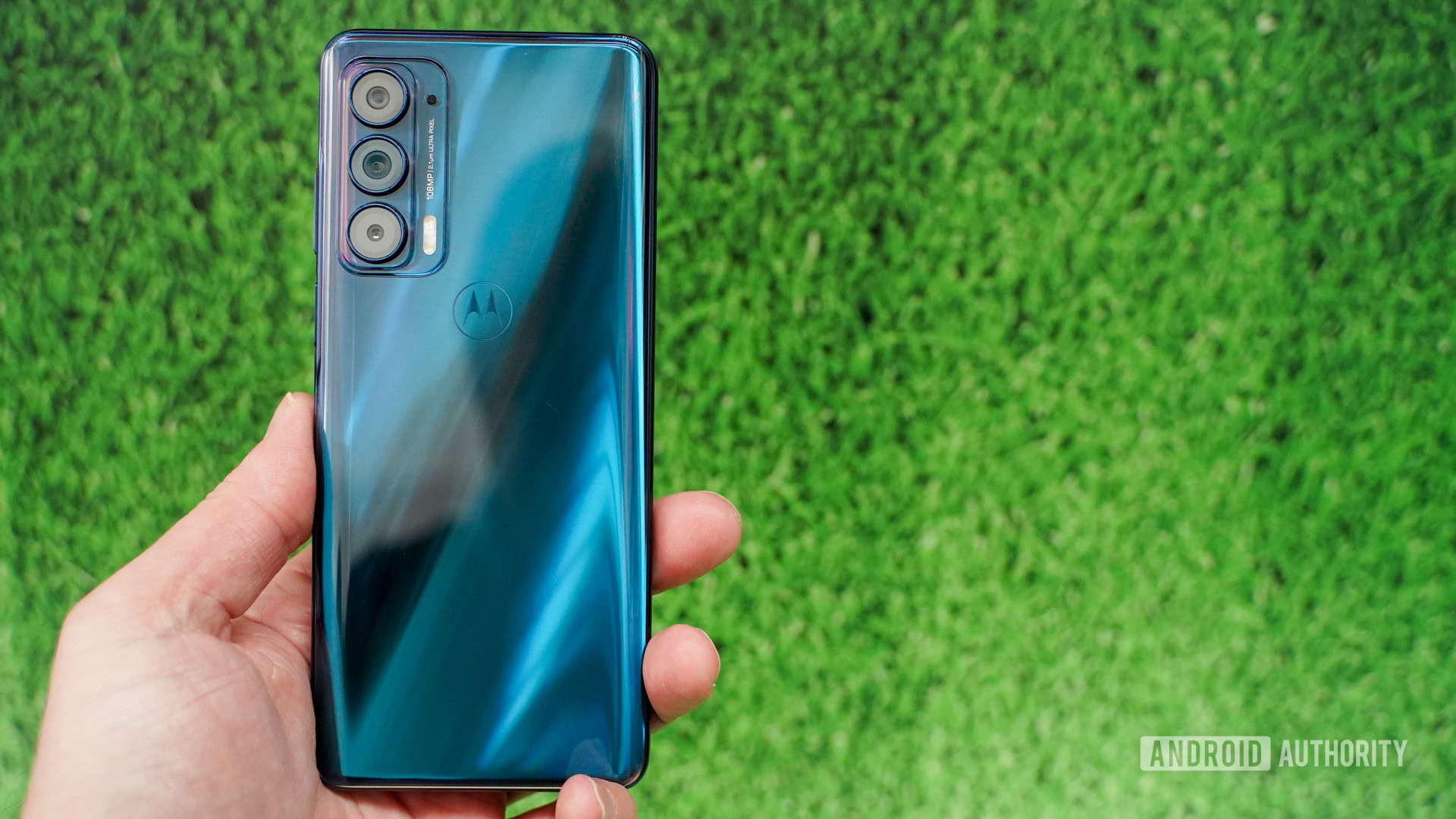Affiliate links on Android Authority may earn us a commission. Learn more.
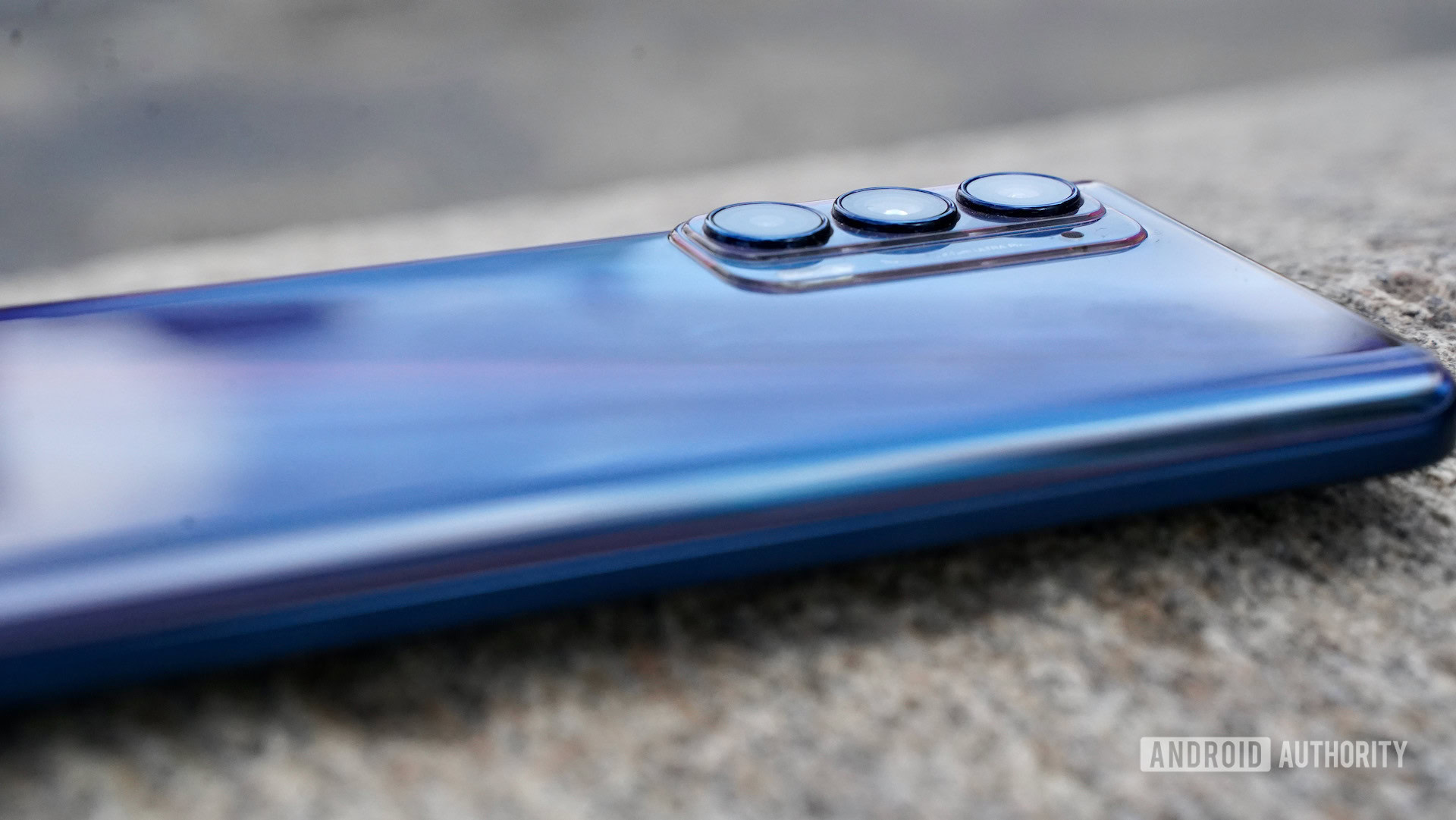
Motorola Edge (2021)
MSRP:
What we like
What we don't like
Our scores
Motorola Edge (2021)
The Motorola Edge (2021) is a mid-range model that served as the only quasi-flagship from Motorola for its year of release. Motorola made some significant changes between the 2020 Edge family and the 2021 Edge that result in this phone being less of an upgrade and more of a sideways step. The Edge competes in the market’s affordable flagship range, though it has a bit less flair than some competing $700 smartphones. What’s it like living life with the Edge? Find out in the Android Authority Motorola Edge (2021) review.
Update, April 2022: Updated text to reflect the release of the Motorola Edge Plus (2022) and other mid-range competitors.
What you need to know about the Motorola Edge (2021)
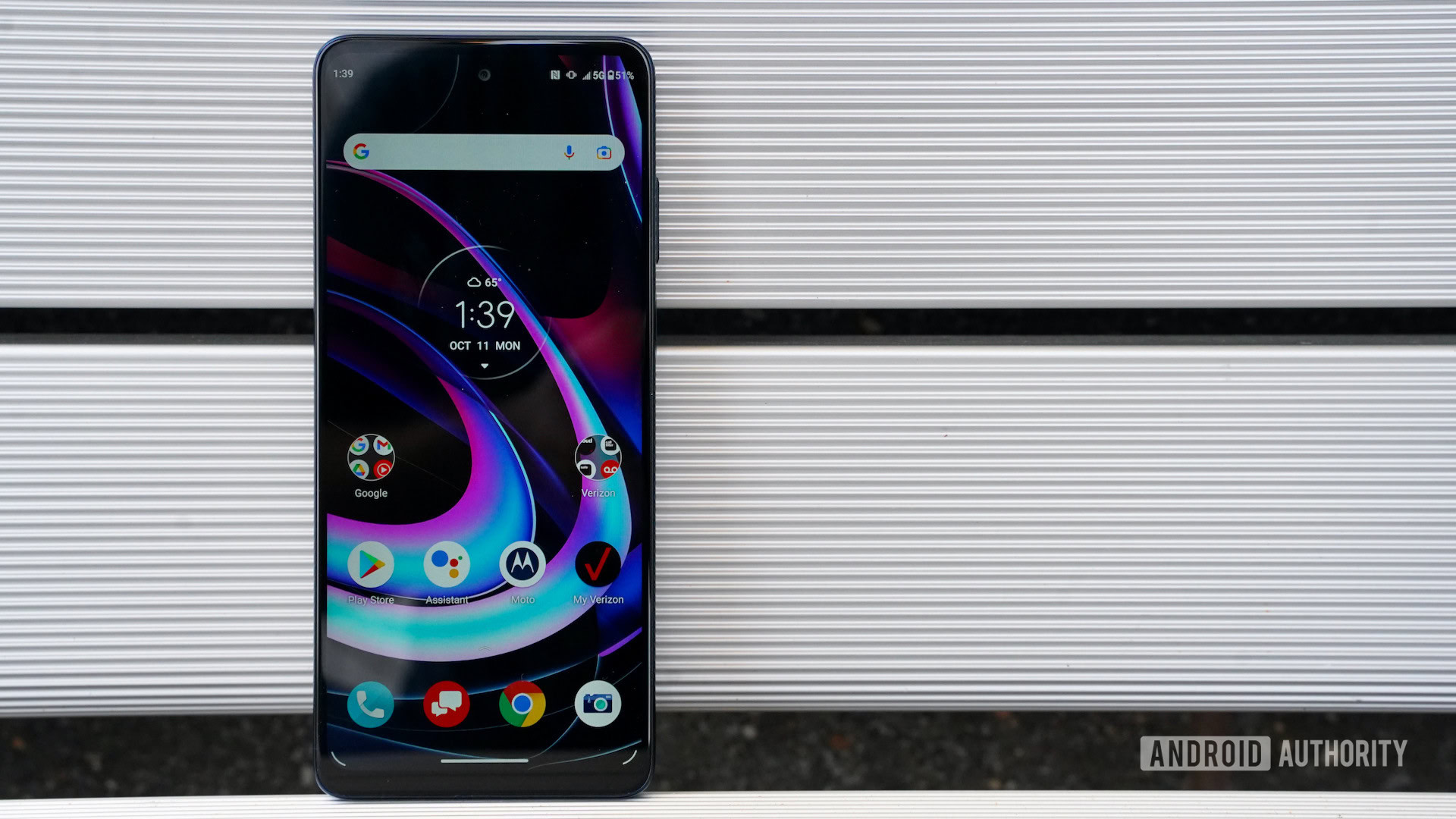
- Motorola Edge (6GB/128GB, Verizon): $549.99
- Motorola Edge (8GB/256GB, unlocked): $699.99
The Motorola Edge (2021) isn’t as sharp an offering as it used to be. In 2020, Motorola introduced the Edge series with a sub-flagship and a high-end offering, the Edge Plus. In 2021, there was the standalone Motorola Edge for the US and then the Edge 20 series for the rest of the world. The Edge 2021 has since been superseded by the Motorola Edge Plus (2022), though it may be that we receive another vanilla Edge phone for 2022 — we’ll have to wait and see. Regardless, the Edge Plus (2022) aims a little higher in some respects, but not always successfully. Check out our review for more info.
Motorola made some interesting choices when it designed the 2021 Edge. The phone swapped out the appealing premium metal and glass materials of its predecessor for a polycarbonate chassis that may be tougher but is decidedly less inspiring. At the same time, Motorola boosted many of the core specs to improve performance. Did Motorola make the right trades to appeal to consumers? With competitors including the OnePlus 10 Pro the Apple iPhone 13, and the Samsung Galaxy S22, it may be harder than ever to say yes — at least for the pricier unlocked version.
The phone comes in a single color, Nebula Blue. In the US, the Edge will be sold both unlocked with scattered carrier compatibility along with a dedicated version just for Verizon. The unlocked model ships with a healthy 8GB RAM and 256GB non-expandable storage combo, while the Verizon version (which we tested) has a more limited 6GB/128GB memory and storage combo — but drops the cost to a mid-range price tag. The unlocked phone is available directly from Motorola’s website as well as online retailers including Amazon and B&H Photo. There are no price drops or discounts on the phone at this time.
Let’s take it to the edge.
How is the design?
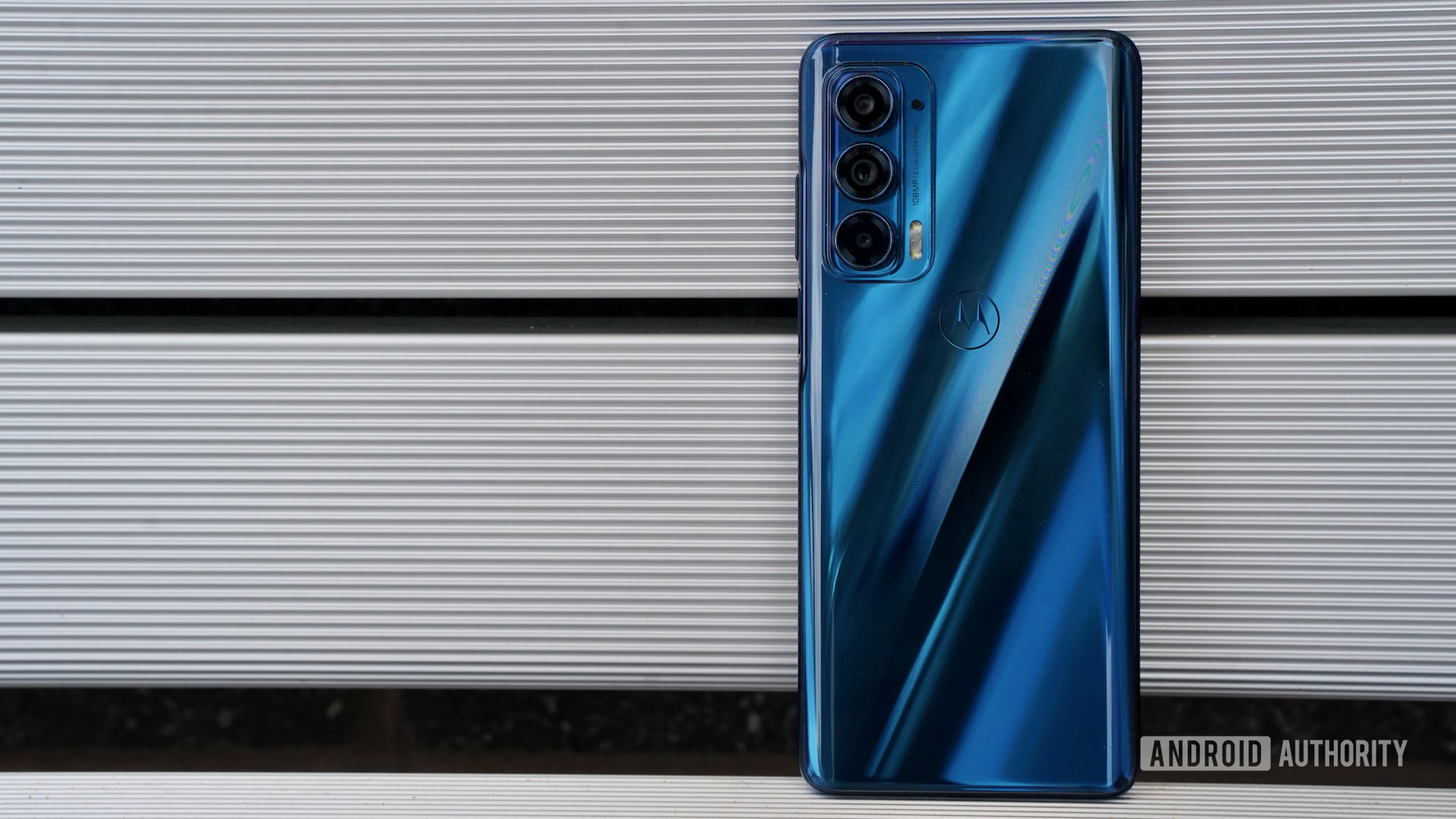
Motorola’s decision-making process had us scratching our head just a little bit. The 2020 Edge featured an appealing design with an edgeless glass display, a metal frame, and high-quality components. Things took a turn with the Motorola Edge (2021) and I’m not sure if the company has lost its way in the process.
To start, Motorola traded the metal frame for polycarbonate. It has a metallic paint finish on it, sure, but that’s simply not the same thing. The frame is thick and wraps all the way around the phone’s middle. Aging Gorilla Glass 3 glass forms the flat front panel, but the rear panel is made from layered polymer. We wouldn’t mind so much if the frame and rear panel didn’t feel like plastic, but they do. The whole build comes across as a step down from the previous generation in terms of aesthetics. That’s not to say it’s poorly built. It’s a solid piece of hardware that’s fitted together tightly. The plastic components mean it’s a fair bit tougher than a dual-glass design — though don’t take that to mean the phone is in any way rugged, especially with its outdated display glass protection.
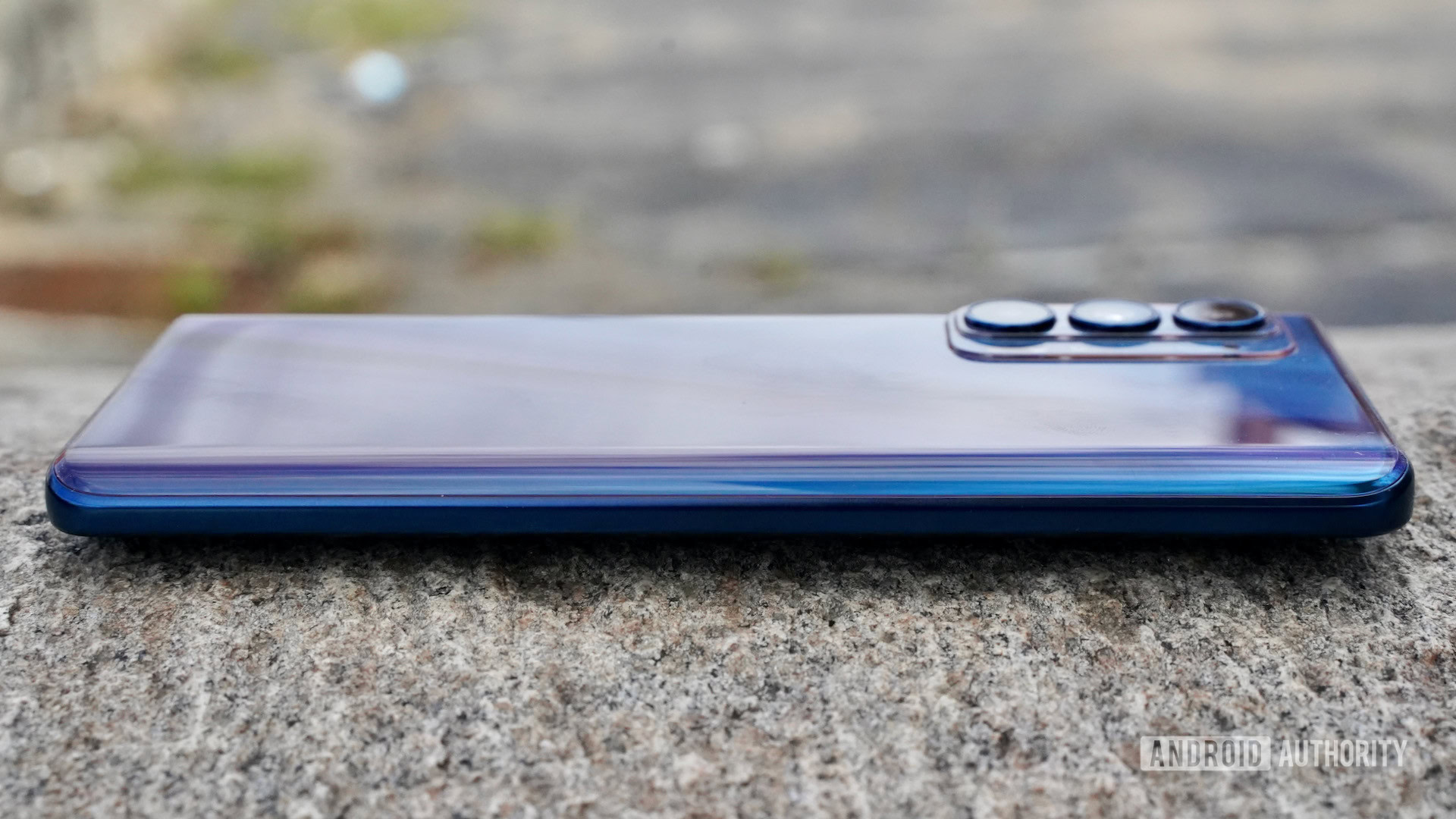
Thankfully, its looks don’t give away its inadequacies. From a distance, the phone resembles every other glass slab on the market. Motorola has really fallen in love with deep blue hues and the Nebula Blue almost has hints of aqua. Where the frame has more of a dark matte finish to it, the rear panel is glossy to a fault. It’s highly reflective and collects fingerprints and smudges with the lightest touch. It’s nigh impossible to keep clean. In addition, the camera module on the rear panel is absolutely enormous and the three lenses are huge and stick out quite a bit.
Motorola nixed a headphone jack and stereo speakers from the Edge.
You can’t call the phone small, either. At 169 x 75.6 x 8.99mm, the Motorola Edge is a sizable smartphone. Motorola kept the weight down, at just 200g. It stretches the hand to use but doesn’t weigh you down as a result.
Controls and other hardware features are kept to a minimum. Only two buttons adorn the right edge, including a volume toggle and combination power button/fingerprint reader. The volume toggle is a little on the small side, which makes it tougher to tell up from down. The fingerprint reader is a cinch to train and use. I found it to be accurate and quick enough to rely on as my main method for unlocking the phone.
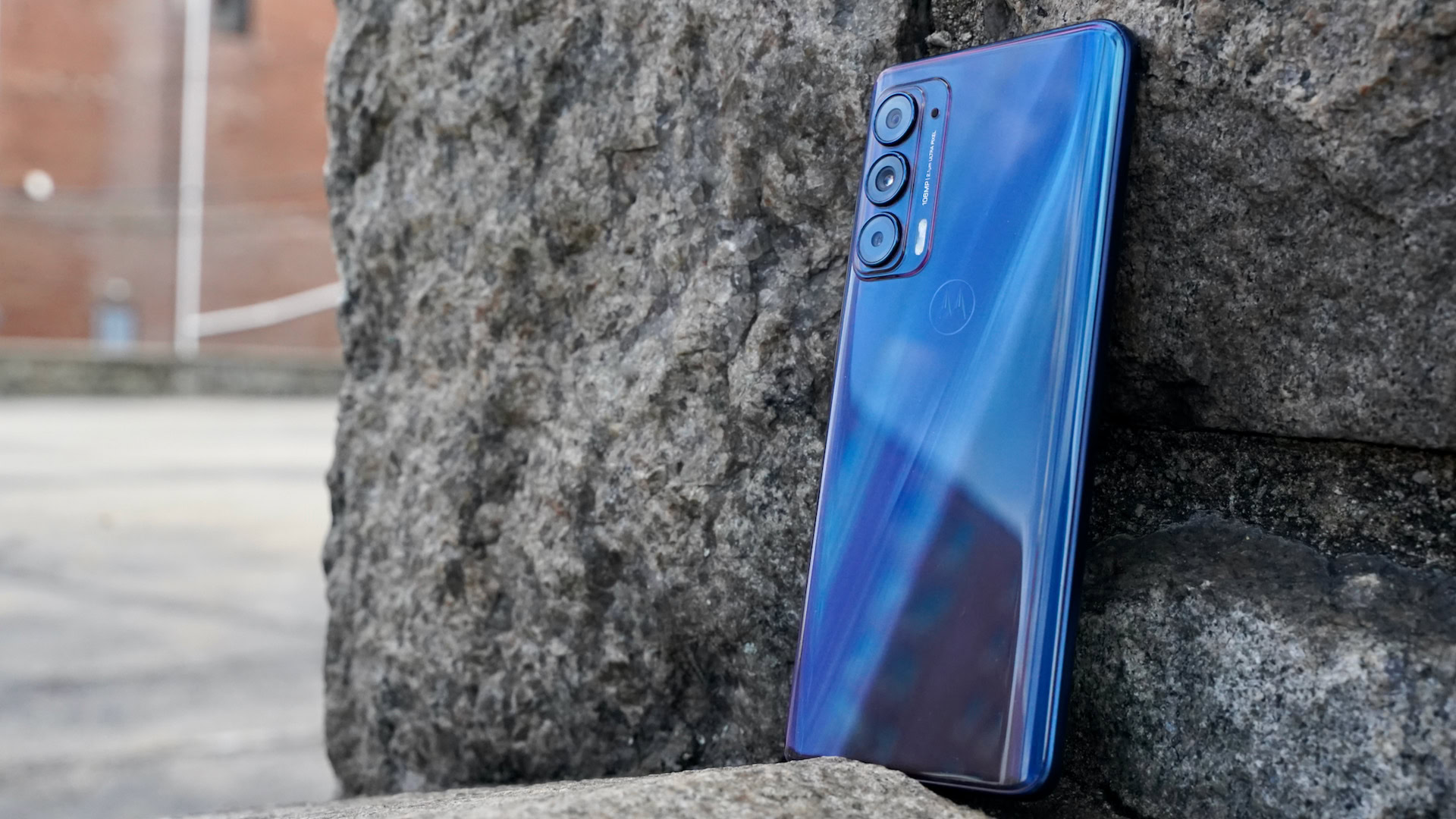
Motorola opted not to include a 3.5mm headphone jack but that’s not particularly surprising. What is surprising is that Motorola also dropped the stereo speaker arrangement of the 2020 Edge phones for a single speaker on the 2021 model. This makes no sense. Many competing phones in this price range have stereo speakers. The downward-firing speaker is really loud and sounds pretty good, but stereo speakers are far more preferable when watching video on expansive displays such as this.
Related: Smartphones with the best speakers
The Motorola Edge is not as protected from dust and water as well as most other phones in its category. It carries an IP52 rating, which means it can handle light splashes. This is a far cry from the IP67 and IP68 ratings of phones such as the iPhone 13 and Galaxy S22.
In all, the hardware experience is a bit of a letdown when the phone is pitted against its predecessor. It’s a clear backward step in terms of design and materials. Moreover, the Edge does less to compete with phones that do offer appealing metal-and-glass builds, higher protection standards, and stereo speakers. We’re still scratching our heads on this one.
How is the screen?
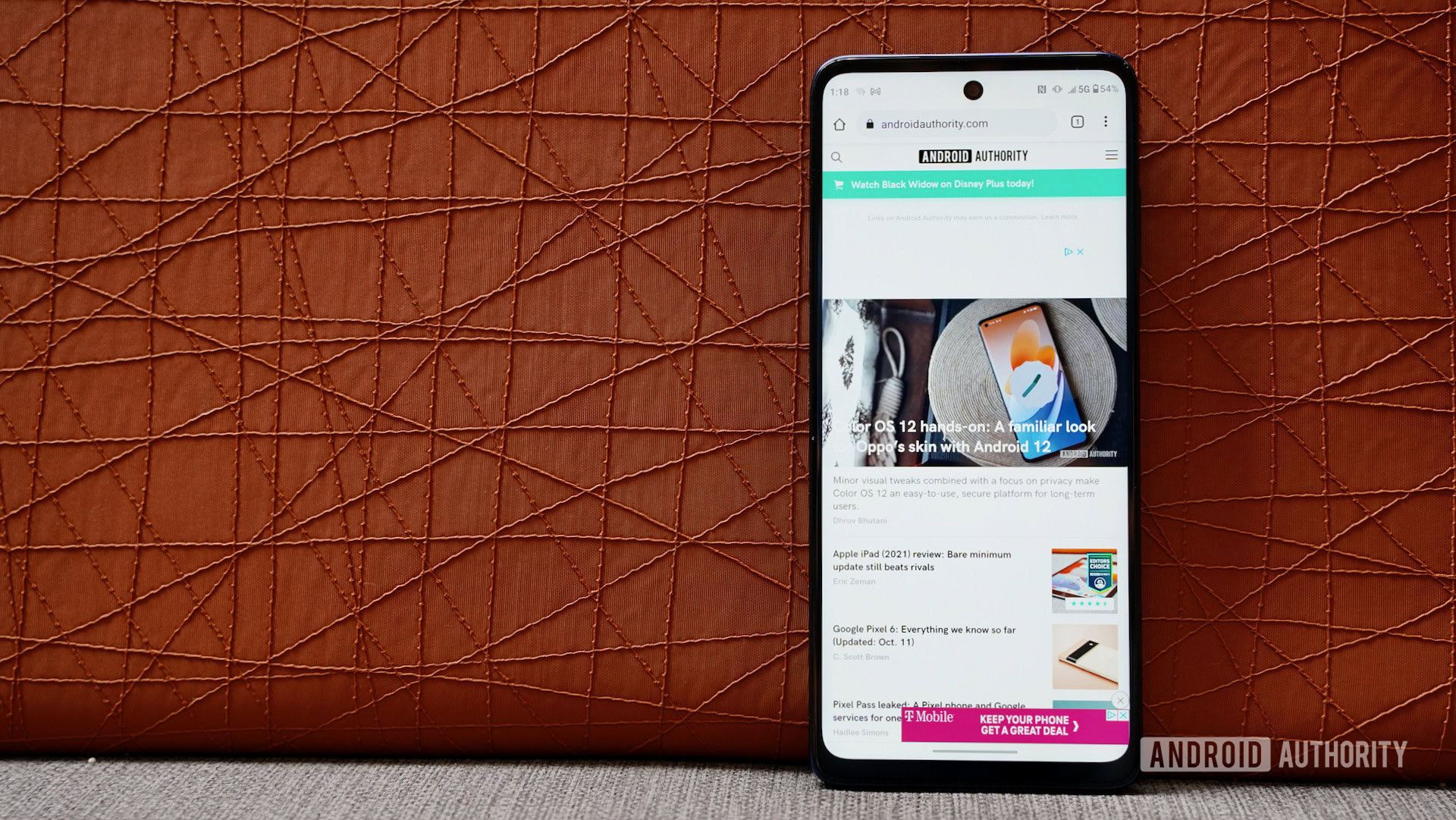
Other than the plastic build, the display is what represents the biggest outward change between the 2020 and 2021 Motorola Edge phones. Where the 2020 model had a curved screen with no side bezels and a 90Hz refresh rate, the 2021 model has a flat screen that does have side bezels (albeit kept to a minimum) but a faster 144Hz refresh rate.
Motorola improved the screen's refresh rate year over year from 90Hz to 144Hz.
The Motorola Edge (2021) features a 6.8-inch LCD screen with an FHD+ (2,460 x 1,080) resolution, a 20.5:9 aspect ratio, and a punch hole camera cutout at the top. As far as LCDs go, it’s a fine screen. We can’t complain about the size or the sharpness. Websites and video content alike come across cleanly and with good detail. The brightness could go higher and the glass is rather reflective. These two taken together mean that even when the screen is set to its maximum brightness the Edge’s display can be hard to see outdoors.
Motorola improved the screen’s refresh rate year over year. The Edge has three refresh rate settings and the one you choose will have an impact on battery life (more on that below.)
Out of the box, the phone is set to an “auto” rate, which varies the refresh rate between 10Hz and 120Hz depending on the content you’re viewing in order to balance smooth performance with battery life. If you wish, you can peg the refresh rate at a static 60Hz for better endurance or a static 144Hz for the smoothest experience at the cost of higher battery consumption. My eyes had a hard time seeing any difference between the auto setting and the 144Hz setting, but stepping down to 60Hz resulted in a fairly obvious change in scrolling behavior. I think most people will get the best from the screen by keeping it set to the auto option. Competing phones in this price category often have 90Hz or 120Hz displays, so Motorola definitely upped the ante here.
See also: Display specs and terms explained — resolution, contrast, color gamut, and more
Motorola says the screen has a touch response rate up to 576Hz, which is more than most other phones in this category. Basically, it means the screen reacts to your touch input much faster. This can help give you the edge (pun intended) in some games. It is only available when using the phone’s gaming mode.
Because this is a Motorola phone, you have an incredible amount of control over the behavior of the lock screen. It includes an always-on display and features advanced tools that let you peek at the content of emails and messages without unlocking the phone. You also have total authority over things like font sizes, night mode, and the like.
Motorola put together a fine display for the Edge, I just wish it could get a little brighter.
What is battery life like?
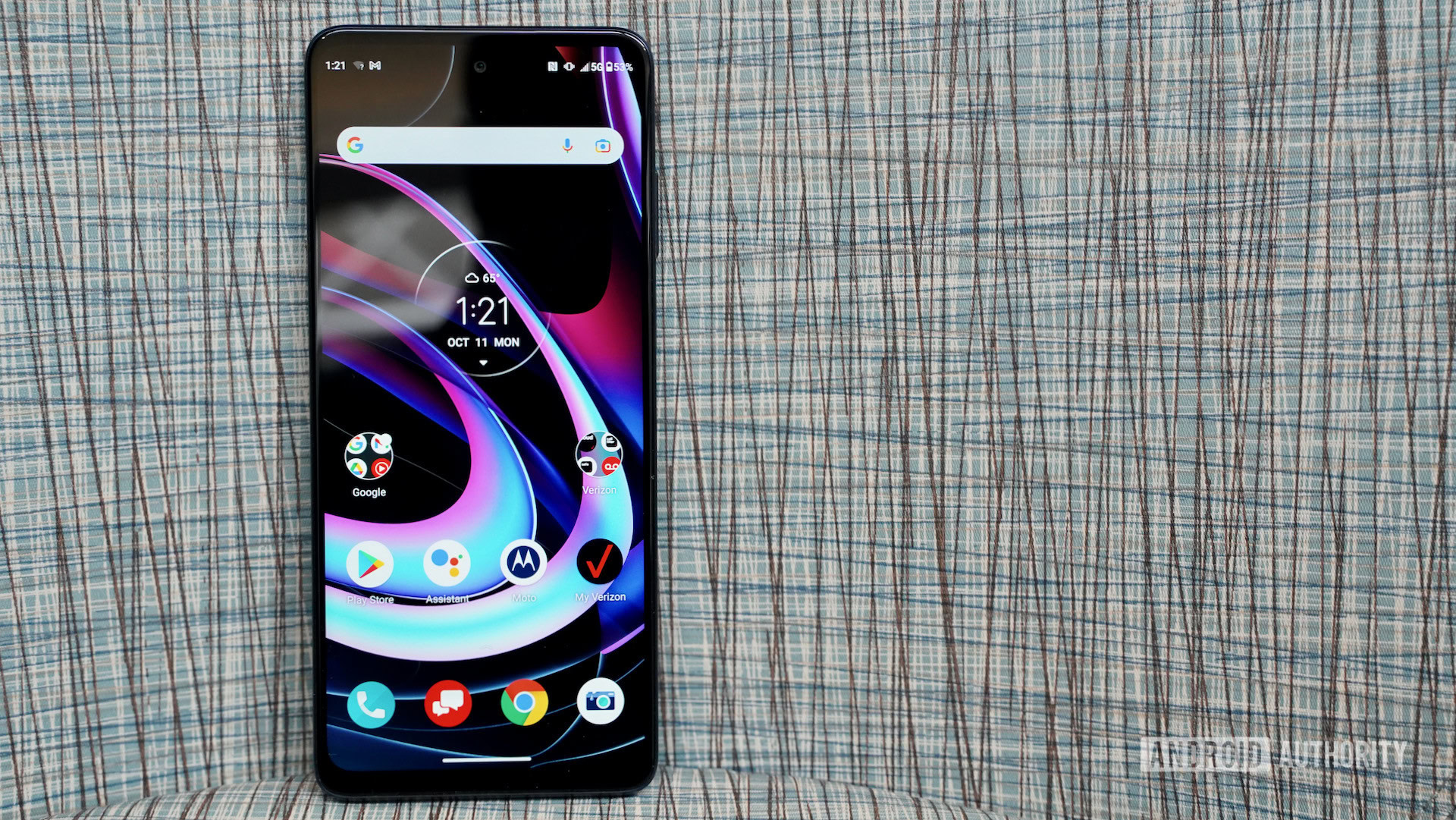
Motorola boosted the battery capacity from 4,500mAh in the 2020 phone to 5,000mAh in the 2021 model. That’s a nice upgrade, though it is partially offset by the jump in the display’s refresh rate.
The company claims the phone should consistently provide two days of battery life and we found that to be mostly true. It does depend on plenty of factors, including the setting you pick for the screen. In order to get through the two full days, you have to opt for the 60Hz display setting. With that option selected the Motorola Edge easily sailed through two full days. Sticking to the factory display setting (variable up to 120Hz) nets you closer to one and a half days of battery life, which is still good. Going with the full-speed 144Hz refresh rate gives you something like one and one-quarter days of battery life. Again, that’s not bad. Screen-on time maxed out at close to seven hours with the phone in the auto setting.
Plugging in for just 10 minutes will net you nine hours of up time.
Need to recharge? The Motorola Edge supports 30W wired “TurboPower” charging via the included plug. It’s not the fastest charging phone in this price category but it still beats some phones (ahem, iPhone 13). Getting the 5,000mAh battery from dead to 100% took about 75 minutes, but plugging in for just 10 minutes will net you nine hours of uptime.
Related: Here are the Android phones with the best battery life
The phone doesn’t support wireless charging. This feature is increasingly common in this price range, though it’s more a more acceptable absence for the cheaper Verizon model. Nevertheless, Apple and Samsung have added it to their ~$700 phones, so it’s a shame Motorola left wireless charging off the Edge’s feature list.
How powerful is the Motorola Edge (2021)?
Motorola upgraded the Edge’s processor from a Qualcomm Snapdragon 765G in the vanilla 2020 model to a Snapdragon 778G in the 2021 phone. Motorola makes an 8GB model of the Edge (2021) available, but our review unit was limited to 6GB of RAM.
In terms of everyday performance, the Edge handled everything we threw at it really well. The entire user interface, including swiping around the menus, opening apps, and multitasking, was fluid and smooth. We didn’t experience any lagging or slowness as we used the phone for normal smartphone stuff. That included plenty of social networking, work communications, gaming, media streaming, and similar.
Dive deeper: Snapdragon SoC guide — Qualcomm’s smartphone processors explained
The Snapdragon 778G is not a barnstormer when it comes to benchmarking. The SoC put up decent numbers for its category and is a nice generational improvement, but it won’t be challenging any modern flagships any time soon — and that’s the problem. Some competing ~$700 Android phones have leading silicon from Qualcomm. Even some affordable flagship-style devices, including the Motorola Edge 20 Pro for those outside the US, have opted for the still impressive Snapdragon 870. This is a bit of a misstep for Motorola.
Meanwhile, Apple’s iPhone 13 series features the blazing fast A15 Bionic, while the Galaxy S21 and OnePlus 9 are powered by the elite Snapdragon 888. The upper mid-range Snapdragon 778G, while more than enough for everyday usage scenarios, simply can’t keep up with the top chips when put under pressure. It performs well in real-world tests now, but it could hold the Edge back as the phone begins to age.
How good is the Motorola Edge (2021) 108MP camera?
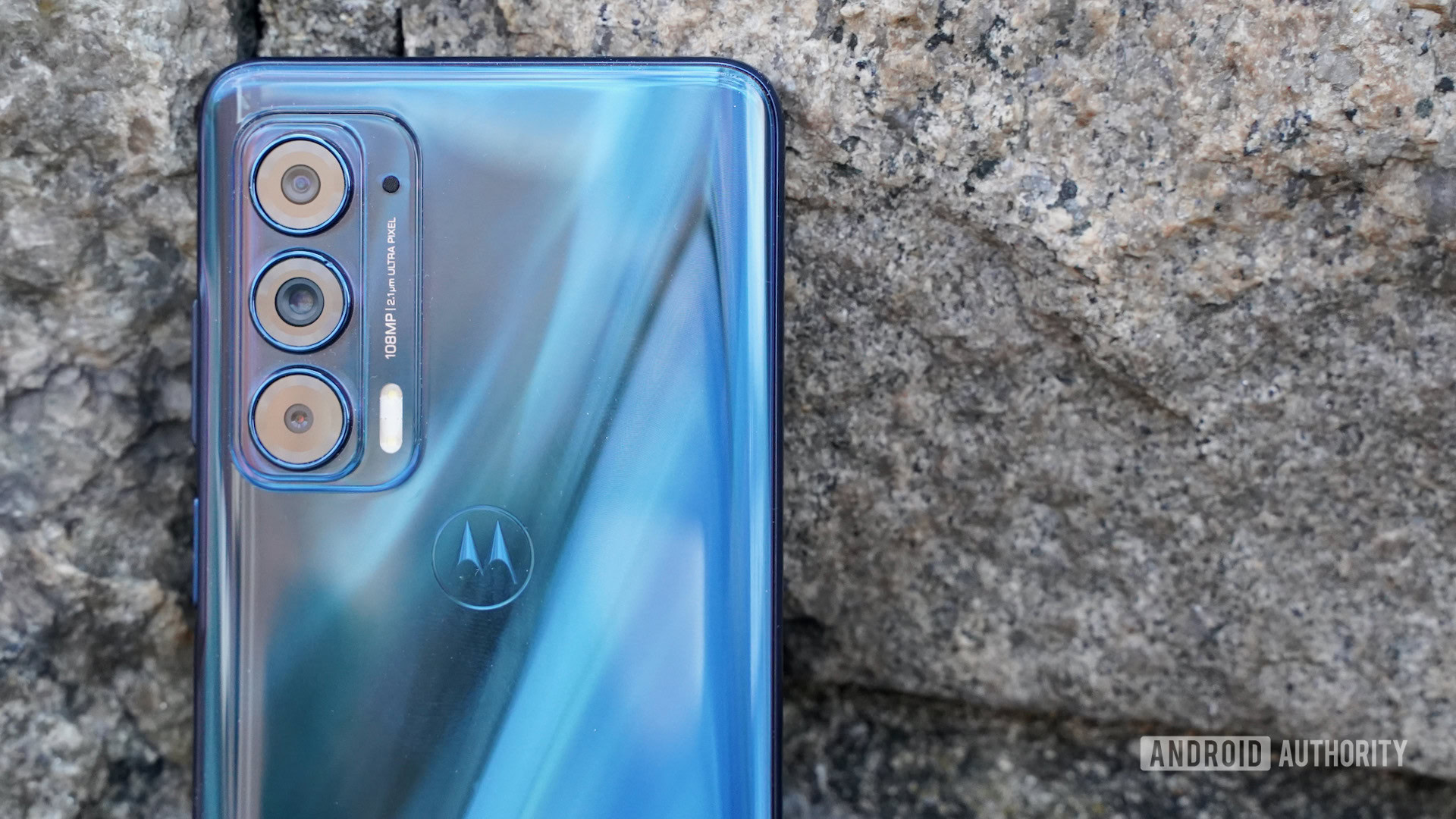
The camera is another place where Motorola took a sideways step rather than marching clearly forward. The 2020 Motorola Edge had a flexible camera configuration, including standard, telephoto, ultra-wide, and depth sensor options for imaging. For the 2021 phone, Motorola doubled the resolution of the main camera but dropped the telephoto lens entirely. Ugh! Granted, many competing phones in the $700 space have only main and ultrawide lenses (with Samsung being the notable exception), but it would have been nice if Motorola had stuck with it.
See also: The best camera phones you can get
The main sensor packs 108MP and relies on nona-binning to create large, light-sensitive pixels when shooting everyday shots. The ultrawide is an 8MP affair with a wide 119-degree field of view, while the 2MP depth sensor is utilized for portrait bokeh effects. On the front, the selfie camera snaps 32MP photos and bins down by a factor of four to 8MP.
Most images from the main camera are solid enough when there’s good lighting. The daytime shots we captured were on par with some phones in the segment in terms of focus, exposure, and color. HDR performance could be better, as some shots ended up with really dark spots in them. Low light samples, such as the shot of the cat, really lose detail and clarity thanks to noise. Plus, the camera wasn’t fast enough to create a sharp shot of a moving animal.
The ultrawide camera isn’t quite up to par. Shots have more grain in them and are more contrast-y in nature. Moreover, any sort of HDR functionality seems to have been tossed out the window. There’s lots of shading and overblown regions in the photos.
Due to the lack of a telephoto shooter, all zoom is accomplished digitally using the main camera. You can dial in 2x, 5x, and up to 10x using the main camera’s healthy number of pixels. Results aren’t that great, as you can see below.
There is a night mode available for shooting in the (near) dark. Like other phones with this mode, the Edge shoots a long exposure in order to capture more light. Getting good results requires you to hold still. The results are generally a bit soft and noisy.
The 32MP selfie camera leaves a little bit to be desired, too. Regular selfies turn out decent enough in solid lighting conditions, though they are a bit varied in terms of contrast. Selfies really suffer in anything less than perfect light. That means your nighttime adventures won’t get quite the photos they deserve. Portraits are actually pretty good, with nice edge detection and a pleasant background blur.
The app is as usable as any I’ve seen. The basic viewfinder is simple enough, with controls letting you switch between the main and video cameras. Reaching the simple settings is as easy as tapping the little arrow next to the shutter button. There’s a separate menu button to tap if you want to reach all the various shooting modes, of which there are plenty.
Whether you’re shooting from the main camera or the front camera, video capture is limited to 4K at 30fps. That’s short of the 4K at 60fps available from almost all competing phones, and far behind the 8K capture that a handful of devices can capture. The footage we shot was on par with the photos we snagged from the main camera. That is to say it was generally clean with good color and sharp focus. The 1080p at 30fps footage we shot was really good looking and that’s what we recommend most people stick to.
You can view full-resolution photo samples in this Google Drive folder.
Anything else?
- Motorola My UX: Motorola calls its Android software customizations My UX. From a user perspective, it looks almost identical to stock Android. That’s the good news. Motorola’s software then augments Android 11 mostly through the separate Moto app. This app is where you can take advantage of Motorola’s tools, such as the chop-on flashlight or twisty camera. It also simplifies the process of setting up the phone and adjusting things such as wallpapers, styles, the display, gaming, and more. Gaming, for example, allows you to mute calls/notifications as well as disable certain screen gestures that might be misinterpreted during a game. It’s all good.
- System updates: Motorola has committed to two major system updates for this phone in addition to three years of security updates, applied monthly or quarterly depending on various factors. This isn’t the absolute best commitment in the market, and it has fallen behind the competition since launch. Though Motorola announced an Android 12 update for this phone, the Edge (2021) is still waiting on the OS upgrade. Google and Samsung offer much better software commitments for devices that are in the same price range as the Motorola Edge, so if you’re serious about software support, the Edge is left rather blunt.
- Verizon Adaptive Sound: The Motorola Edge is one of the first handful of phones to reach the market with Verizon’s proprietary Verizon Adaptive Sound (VAS). This is a new software-based tool that changes the sound experience when connected to Bluetooth headphones, smart speakers, or car stereos. The good news is that it works with any type of content, such as music or movies. VAS expands the soundstage in a clear way when you’re listening and it allows for customization, individual sound profiles, and such. I tested it out via my Bluetooth headphones and can confirm that it impacts the sound in an interesting way. I’m not sure it will appeal to everyone, but at the very least it’s something to futz with if you like to personalize your device’s audio signature.
- Connectivity: The Motorola Edge (2021) supports Verizon’s sub-6GHz and mmWave 5G, as well as T-Mobile/Metro’s sub-6GHz 5G. We tested the phone on Verizon’s 5G network and found it did really well. It was quick and speedy on the data connection. However, for all others US carriers, the unlocked model supports LTE 4G only. That’s a real shame. Beyond cellular data, the phone supports Wi-Fi 6E, which is the top available Wi-Fi tech, as well as Bluetooth 5.2, the most current Bluetooth spec. These category-leading capabilities help future-proof the phone to some degree, meaning those who hold onto it for a few years will find themselves always able to get the best from their Wi-Fi and Bluetooth radios.
Motorola Edge specs
| Motorola Edge (2021) | |
|---|---|
Display | 6.8-inch FHD+ LCD 144Hz refresh rate 576Hz response rate 20.5:9 aspect ratio |
Processor | Qualcomm Snapdragon 778G CPU Adreno 642L GPU |
RAM/Storage | Unlocked: 8GB/256GB Verizon: 6GB/128GB |
Camera | Rear: Wide: 108MP, f/1.9, 0.7µm pixels, 2.1µm ultra pixels Ultra-wide: 8MP, f/2.2, 1.12µm pixels, 119-degree FoV Depth: 2MP, f/2.4, 1.75µm pixels Video: 4K @ 30fps, slow-motion FHD at 120/240fps Front: Selfie: 32MP, f/2.25, 0.7µm pixels, 1.4µm Quad Pixels Video: 4K @30fps |
Battery | 5,000mAh 30W TurboCharge |
Connectivity | mmWave 5G Sub-6GHz 5G LTE 4G Wi-Fi 6E Bluetooth 5.2 USB-C |
Dimensions/weight | 169 x 75.6 x 8.99mm 200g |
Colors | Nebula Blue |
Value and competition
Motorola has not made our job as reviewers easy with the Motorola Edge (2021). The unlocked model, at the full $699 price, clearly plays in the same space as sub-flagships where it’s entirely outmatched. Even if we ignore the deficiencies compared to 2020’s Motorola Edge, the Edge of 2021 still falls short of the ~$700 competition.
The real, ongoing issue here is pricing. There are things to like about the phone but, put simply, it doesn’t deserve to cost $699. The good news is the Verizon version, though it has less memory and storage, is more reasonably priced at $549.
The Edge of 2021 falls somewhat short of the competition in a few key areas and doesn't earn its $699 price tag.
The Motorola Edge (2021)’s closest competitor is the Motorola Edge Plus (2022) ($999). It’s priced much higher, but that comes with some upgrades. It has stereo speakers, a Snapdragon 8 Gen 1 processor, a better camera arrangement, improved battery life, and more powerful software. Sadly, it’s still lacking a metal frame, an IP rating, and a competitive update commitment. The Verizon variant of the 2022 Edge Plus ($849) is closer to the price tag of the Edge (2021).
What else can you get for about the same retail price as the Motorola Edge? Plenty. There’s the vanilla Samsung Galaxy S22 ($799), which is the total package. It’s got every feature you could want, including wireless charging and much better and more versatile cameras, and longer software support. The S22 is worth the extra $100. You could splurge a bit more and go for the Galaxy S22 Plus ($999). It’s got better battery life and even better cameras.
You might consider phones such as the Samsung Galaxy S21 FE ($699), which is also a little overpriced for what you get, but handily beats the Edge (2021) in most categories. For even less, you might consider the Google Pixel 6 ($599), which has a superior camera and a better update commitment from Google. Last, the Samsung Galaxy A53 5G ($449) goes even cheaper, but is a great budget buy.
There’s also the Apple iPhone 13 ($799) or iPhone 13 Mini ($699). Obviously these trade Android for iOS, but they deliver big on performance, camera quality, and software support.
Motorola Edge review: The verdict
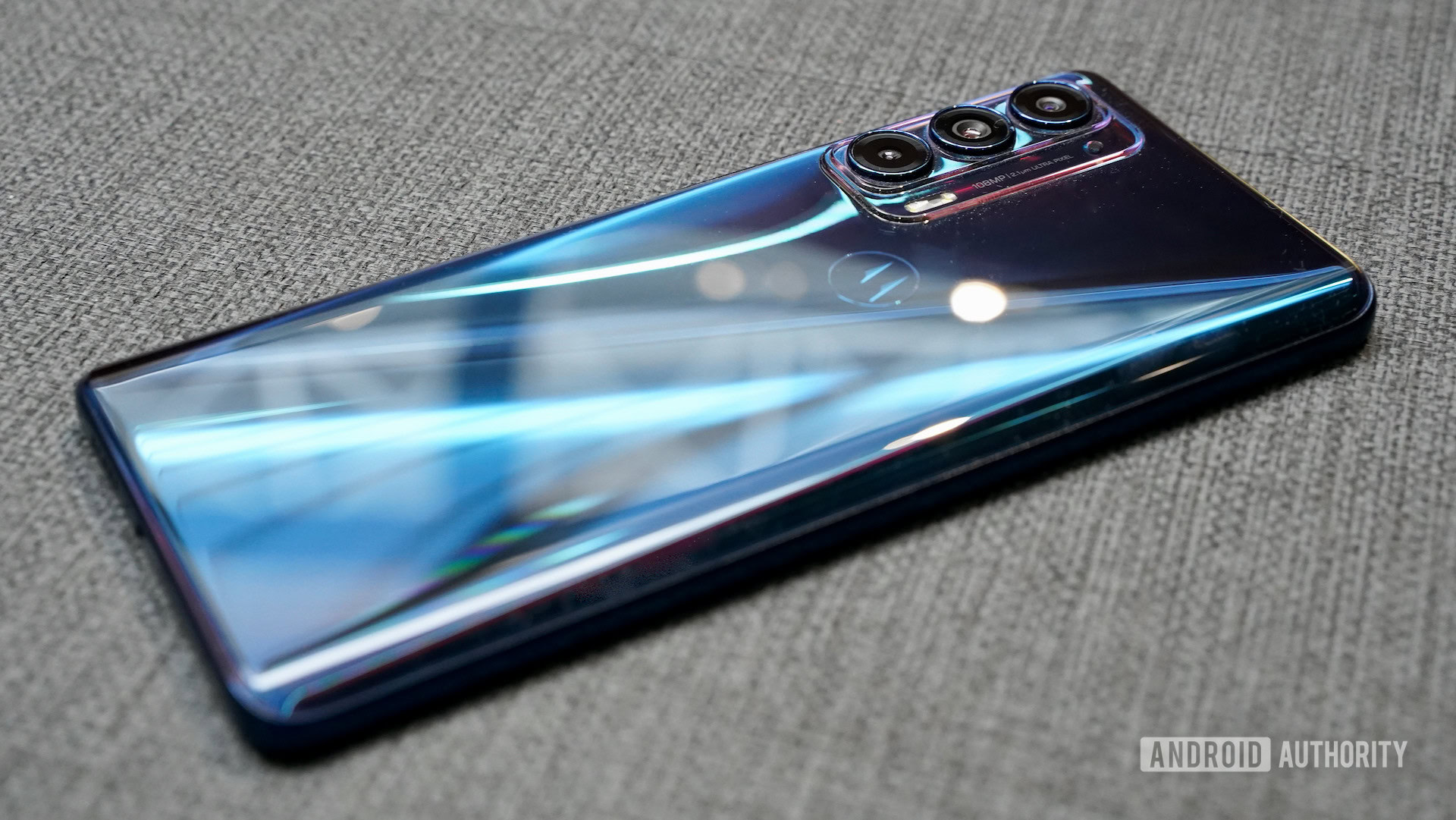
The Motorola Edge (2021) is a puzzling device. It’s clearly a step up from Motorola’s G series devices and yet it failed to advance the flagship Edge nameplate in a meaningful way.
Perhaps the most glaring omissions as far as features are concerned would be wireless charging and a higher level IP rating. The competition often also offers higher quality metal components, stereo speakers, and better cameras. Likewise, while the design is standard fare for the price point, Motorola made an error by dropping the metal framing for plastic. The experience of holding and using the phone simply can’t match metal-clad handsets.
The best value here is for Verizon customers.
Motorola’s phone does have a few things going for it. First there’s the generous and sharp screen, the killer battery life, and leading connectivity suite (as long as you’re on Verizon or T-Mobile for 5G). Motorola’s My UX additions are tasteful and genuinely helpful.
The best value here remains with Verizon customers. Yes, they’ll get less RAM and storage, but they’ll gain mmWave 5G and baked-in carrier support. And at $549, the Verizon model makes a lot more sense.
The Motorola Edge (2021) is a serviceable smartphone and is decent as an upper mid-ranger in Verizon’s portfolio, but as a full-price proposition, it fails to live up to the sub-flagship phones with which it competes.
